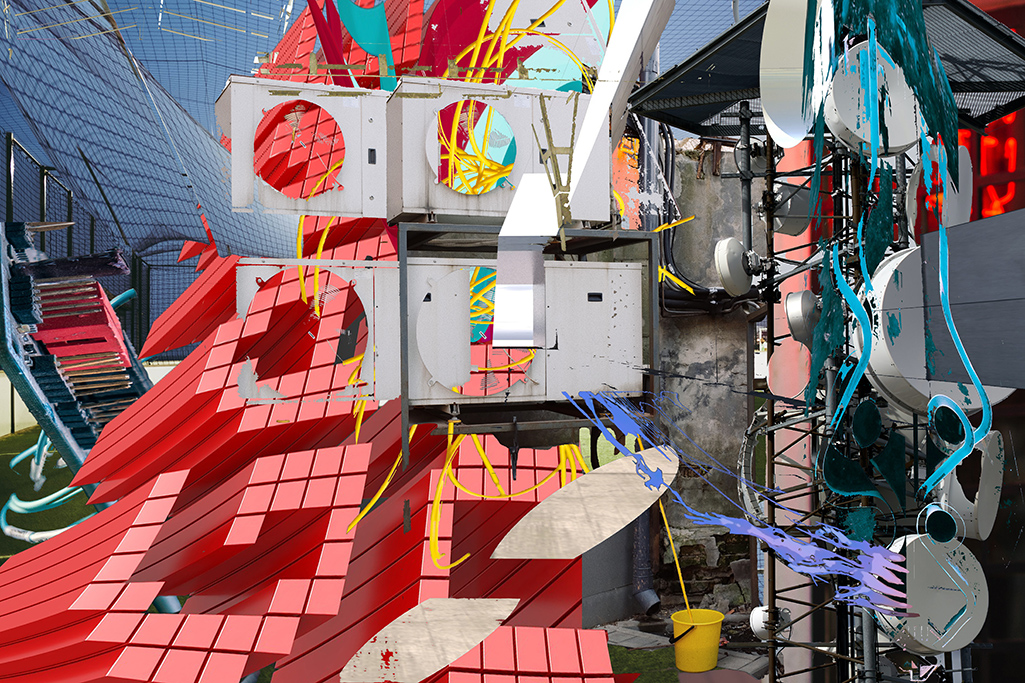By: Sam Moore
Untitled (A glitch in the matrix)
“It was a cliche thought, but Maria had always sympathised with the monster.” This throwaway line from Imogen Binnie’s Nevada (2013, p.22) is an echo of a common thread of trans thinking that can be identified everywhere from Susan Stryker’s seminal 1994 text on Frankenstein, to Preciado’s Can the Monster Speak? (2019). The relationship between monsters and trans bodies can even be encountered in art by cis creators, as exemplified in the many films by David Cronenberg. The similar trope of monster as outsider has existed in the DNA of popular media since Shelly’s Frankenstein: Or, Modern Prometheus (1818), and James Whale’s cinematic adaptation from 1931. Frankenstein’s Monster is also a glitch, something that exists beyond the confines of the world as normally understood; they’re uncanny, uncertain, a body that exists on the fringe. When Dr. Frankenstein has Igor flick the switch and, in a bolt of lightning his creation is (re)born, that same creation is also glitching out, finding a way to exist beyond and between the boundaries of the real world.
The first glitch that I remember was from playing the PS2 game The Simpsons Hit and Run (2003). I remember driving Professor Frink’s rocket car and falling off of the edge of Springfield, somehow ending up beneath the map itself. I twisted the camera to look up at the town while I existed outside of it, a moment of slippage. I remember finding it strange, uncanny, but still somehow tempting. I kept looking for ways to fall off the edge of the map.
In Glitch Feminism: A Manifesto (2020), Legacy Russell argues that the binary body itself exists as a way to limit us, and that the idea of the glitch instead allows us to “consider the in-between as a core component of survival — neither masculine nor feminine, neither male nor female, but a spectrum across which we may be empowered to choose and define ourselves for ourselves.” (p.11) Russell uses the term “fissure” as a way to consider how this glitch is something through which we can fall – like the map in Hit and Run, like the messy body horror transformations of Cronenberg’s horror films – what Russell calls “new possibilities of being and becoming manifest”.
The Creature in Frankenstein is a glitch in between the most existential binaries of all: that between the living and the dead. In the essay Why Frankenstein’s Monster Haunts Queer Art (2017), Charlie Fox writes about how Shelley’s tale “shape-shifts to suit any number of freaky interpretations”, its meaning fluid in a way that allows us to find whatever we may want from it. This, in theory, is one of the ways in which Frankenstein works as a trans text, a trans glitch: we can transform it into whatever we desire. Fox even references “the possibilities of male birth” inherent in how the doctor is able to create life, blurring the lines between the ways in which we understand not just gender as an idea, but also the gendered body and the meanings innate to it.
The trans-ness of body horror is rooted in this idea of what the gendered body is; its meaning, limits, and boundaries. In horror, the body is constantly, relentlessly gendered, in a way that often falls prey to binary, almost essentialist ideas: the Final Girl is historically cis; the body is sexualised in binary ways – this is exaggerated in contemporary, meta-horrors like The Cabin in the Woods (2011) that gender their archetypal characters – stoner, slut, virgin, jock – along gendered lines. But these ideas are often challenged in body horror, narratives that are driven by transformation that pushes against the limits of how we understand the body; pushes up against the limits of the map like a glitch in The Simpsons Hit and Run. In Videodrome (1983), Max Renn’s body transforms in a way that is at once gendered and a refusal of gender as a slit emerges in his stomach and he pulls a firearm from it. This is a temporary transformation, one that comes just as soon as it goes – possibly caused by the strange signals of the Videodrome broadcast itself – as Max finds himself briefly outside of the lines of the boundary. This is to say, Max’s transformation, Max’s (trans) body is a glitch.
In Glitch Feminism, Russell argues that the glitch is a space – which, in video gaming, it so often is; that strange world off the edge of the map – one that allows us to “innovate and experiment”, something that exists in digital spaces and allows us to explore, transform, “faster than AFK mores or the societies that produce them under which we are forced to operate offline.” (p.12)
This distinction between digital and physical realms also has an inherently trans undertone: in Nevada, Maria references the difference between cyberspace and meatspace in Gibson’s Neuromancer (1984). This difference is where trans-ness enters The Matrix (1999).
When Neo is freed from The Matrix, the computer simulation created by machines IRL as a way to turn humankind into batteries, there is a strange freedom that comes from the ways in which he returns to The Matrix; his newfound knowledge gives him access to superhuman feats and, in the film’s final act, he’s able to see and manipulate the source code of The Matrix itself. It’s like hacking, or cheating in a video game: he can learn kung-fu at a moment’s notice or transform his aesthetic into something idealised. When he and Trinity return to The Matrix to wreak havoc, they end up looking like a leather-clad T4T couple. The Matrix is also a world where glitches matter – deja vu is referred to as “a glitch in The Matrix”, a sign that something within the code, the world itself, has changed. This is another moment of slippage.
A glitch in The Matrix feels akin to the trans slippages of (body) horror, a slippage between boundaries and binaries. A glitch in The Matrix serves as a reminder that it’s a construct, something being manipulated like the product of a videogame level editor. The Matrix, this constructed reality, is nothing more than a pile of code, an endless stream of 0s and 1s; a binary, repeated eternally. It’s ironic, then, that Neo becomes known as the one when he is, in reality, a glitch. This notion of The One – a defining aspect of the mythology of The Matrix – is surprisingly fluid, with meanings that are both messianic, and deeply romantic. For Trinity, Neo is the one because she falls in love with him, and it’s this act of love that produces a glitch in the system of The Matrix, a way for Neo and Trinity to understand themselves anew, breaking down boundaries both within The Matrix, and IRL.
BIO
Sam is a writer, artist, and editor. They are the author of All my teachers died of AIDS (Pilot Press, 2020); Long live the new flesh (Polari Press, 2022); and Search history (Queer Street Press, 2023). They are one of the co-curators of TISSUE, a trans reading and publishing initiative based in London.

